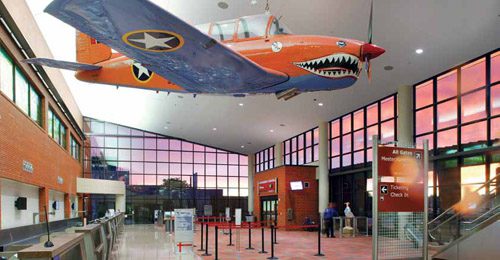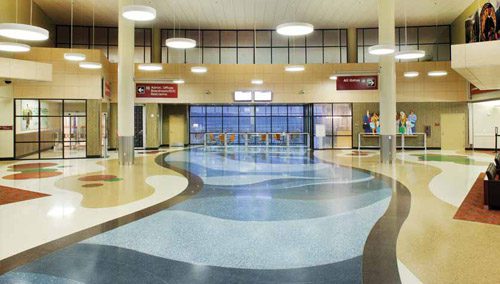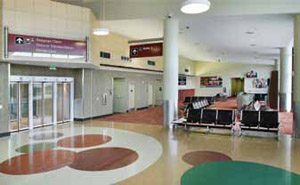
With an overall updated design and the addition of devices to help hearing-impaired visitors, the new $36 million terminal at Kalamazoo/Battle Creek International Airport (AZO) in Michigan is easier on the eyes – and ears – than the old terminal it replaced. It also has new exit lane technology to help deter security breaches and prevent unauthorized access to secure areas.

When the new terminal opened last spring, it came in $4 million under budget and yielded commendations and awards.
|
factsfigures
Location: Kalamazoo/ Battle Creek (MI) Int’l Airport Owner/Operator: County of Kalamazoo Airport Oversight: Airport Aeronautics Cost: $36 million Size: 94,787 sq. ft. Opening Day: Annual Passengers: 141,000 Funding: Bonds, passenger user fees, FAA entitlements & discretionary funds, state-matched funds Architect/Designer: Reynolds, Smith and Hills Construction Manager at Risk: Skanska USA Building Mechanical Engineer: Byce & Associates Paging & Hearing Loop Systems: Ascom Electronic Display System: Infax Network Integrator: Netech Terrazzo Floor Design: SKP Design Exit Lane System Provider: record-USA Exit Lane System Installer: Great Lakes Automatic Door Transition Management: Chrysalis Consulting, LLC Baggage Handling System: Vanderlande Industries Boarding Bridges: ThyssenKrupp Airport Systems Signage and Wayfinding: Muhlhausen Design In-Terminal Advertising: Clear Channel Airports Holdroom Seating: Herman Miller Seating Supplier: WorkSquared Key Benefits: One-third larger than the old terminal, 3 additional gates, increased accessibility & efficiency, enhanced exit lane security, inline baggage screening
|
 At 95,000 square feet, the new terminal is about one-third larger than AZO’s original 1958 facility, which had been expanded twice. Although a cost-benefit analysis of the old terminal detailed significant deficiencies in its mechanical, electrical and HVAC systems and demonstrated the need for a new facility, concerns about federal funding and higher-than-expected construction costs prompted the Kalamazoo County Board of Commissioners to suspend the project in 2005, explains Moshoginis.
At 95,000 square feet, the new terminal is about one-third larger than AZO’s original 1958 facility, which had been expanded twice. Although a cost-benefit analysis of the old terminal detailed significant deficiencies in its mechanical, electrical and HVAC systems and demonstrated the need for a new facility, concerns about federal funding and higher-than-expected construction costs prompted the Kalamazoo County Board of Commissioners to suspend the project in 2005, explains Moshoginis.
“Once the new terminal was put on hold, the fear was it wouldn’t get built,” he recalls.
Getting the project moving again was almost like starting from square one, notes Moshoginis, who has been with the airport since 1993. When he became airport director in 2006, a new design firm – Reynolds, Smith and Hills (RS&H) – took over the project. By building public consensus for a new terminal, RS&H helped build the case for FAA discretionary funding, explains Moshoginis, and ground was broken in June 2009.
 Limited space for the new terminal inspired a two-story boomerang-shaped building that would fit between the existing terminal and the airport rescue and fire fighting station. In retrospect, RS&H senior aviation architect Patrick Hargrove says the space constraints were actually “friends” to the design process.
Limited space for the new terminal inspired a two-story boomerang-shaped building that would fit between the existing terminal and the airport rescue and fire fighting station. In retrospect, RS&H senior aviation architect Patrick Hargrove says the space constraints were actually “friends” to the design process.
The tight site added significant logistic challenges for construction manager at risk Skanska USA Building. Crews had to create a secure bubble onto the airport operations area to keep the airport secure while the new terminal was being constructed.
New Watchwords
With many improvements taking place, the airport’s new tagline became “safe, simple and convenient.”
“That doesn’t mean we weren’t safe in the old terminal,” Moshoginis clarifies, highlighting the new building’s improved accessibility and efficiency.
“People are really impressed with how easy it is to walk through from check-in through security,” he continues.
A new inline baggage handling system screens baggage for explosives and streamlines the ticketing and boarding processes. Other improvements include a second baggage claim device, free Wi-Fi and more spacious boarding areas. The airport also expanded from two to five gates, and each now has its own boarding bridge, which makes ground loading less likely.
The style contrast between the old and new terminals is striking. Instead of dark and dingy, the new facility is light and open, describes Moshoginis. While the old terminal required electric lighting even on sunny days, the new terminal harvests natural daylight with ample windows, including a 325-foot-long curtain wall. Project manager Eric Ferguson of Skanska estimates that 60% to 65% of the building’s exterior is glass coated with high-performance glazing.
In addition to brightening passengers’ days, the natural light highlights aviation- and Michigan-related artwork. A pink Beechcraft T-34, on loan from the nearby Air Zoo, is suspended in the ticketing lobby. The aircraft was flown by the aviation museum’s co-founder, Suzanne Parish, who served with the Women Airforce Service Pilots during World War II and was trained by the airport’s first manager, Irving Woodhams.
 Seven large papier-mâché works in bright colors add a whimsical feel to the new terminal. A near full-scale sculpture of a man about to launch a paper airplane from the second floor often draws smiles from passersby.
Seven large papier-mâché works in bright colors add a whimsical feel to the new terminal. A near full-scale sculpture of a man about to launch a paper airplane from the second floor often draws smiles from passersby.
To include art with local ties, the airport assembled a committee to work with RS&H. The committee focused on creating a cheerful theme throughout the terminal, explains Linda Bunting, airport administrative assistant/public relations liaison and art committee member.
Seven local artists, for instance, transformed furniture into art by hand painting 10 metal benches.

The building itself is organized into layers that correspond to AZO’s functional requirements, says Hargrove. “Each layer supports future growth and inevitable modification over time,” he adds. “The layers are developed to reflect the harmonious way new elements are interwoven with historical elements in the urban fabric of the Kalamazoo/Battle Creek area.”
Exterior brick masonry reflects historical downtown buildings, while a steel canopy adds a modern touch. Inside, a progression toward contemporary styling concludes in the boarding area with a layer of steel and glass. Terrazzo flooring on the second floor depicts the Kalamazoo River flowing through colorful fall trees.
Keeping Everyone In the Loop
In addition to significant visual enhancements, AZO’s new terminal also features auditory improvements. Designers included two new systems to help ensure that visitors with hearing loss don’t miss boarding announcements and other crucial information.
The new terminal’s Ascom paging system is integrated with WinFIDS, an electronic display system from Infax that drives flight information, ticket counter, gate and baggage claim displays. Announcements heard through the paging system are visually displayed on the monitors using an XML-based interface provided by Infax.

Visitors who prefer to listen for announcements but have difficulty hearing them can use the airport’s new hearing loop system. The system magnetically transmits sound to hearing aids and cochlear implants with telecoils. To use one of AZO’s “hearing loops,” travelers switch their personal devices to the T (telecoil) position for clearer, amplified versions of public address announcements. Signs with the universal symbol for hearing loops identify their locations throughout the terminal, including individual devices at ticket counters and in-floor systems in the meet-and-greet hall and boarding areas.
Because the system was installed in zones and phased arrays, passengers using the loops at a given gate hear only announcements for that specific gate and pages intended for the entire airport, notes Tim Vander Meer, engineer and project manager for Hearing Loop Systems.
Without a hearing loop, listening for announcements in high-traffic areas at airports can be especially challenging because they often have hard surfaces like glass walls and terrazzo floors, which reflect sound waves, explains Vander Meer.
AZO and other nearby airports are leading the industry by installing hearing loops thanks largely to the efforts of David G. Myers, a professor of psychology at Hope College in Holland, MI, who champions the cause of such assistive technology.
Open Sesame
AZO’s decision to add a layer of security to its exit lanes is expected to draw attention throughout the industry. The airport’s new FlipFlow system, by record-USA, provides faster passenger throughput than its previous revolving door arrangement, reports Moshoginis
In the new terminal, pairs of automatic glass doors with intelligent sensors separate the boarding area from the meeter/greeter hall. When in “interlock mode,” the FlipFlow system opens one of two glass doors to allow a passenger to step inside a glass “tunnel.” After the entry door shuts, the exit door opens. “Flow mode” keeps both doors open.
With two 35-inch door openings and another 43-inch option to accommodate wheelchairs, more than one person can exit at a time.
Although AZO is the first installation of a FlipFlow system at a U.S. airport, 1,500 have been installed in Europe, reports Marty Licciardello, president of record-USA. Historically, domestic airports have not been as focused on exit lane security as their European counterparts, Licciardello reports. But several major security breaches at U.S. airports caused by people using exit lanes to enter the boarding area led the company to introduce its system here in mid-2010.
Exit lane security breaches are often not committed with evil intent, notes Mark Dugo, vice president of sales for record-USA.
“A girlfriend wanting to give her boyfriend one last kiss goodbye can cause an airport to shut down,” Dugo explains, adding that it can takes hours and millions of dollars to review security video and re-screen passengers at a large airport.
The FlipFlow installation at AZO underscored the lesson that one size does not fit all, Dugo cautions.
“There’s always a tradeoff between security and throughput — and that’s a local decision,” adds Licciardello, noting other products can be used with the FlipFlow system. AZO combines the automatic doors with video surveillance, which is monitored at a security workstation.
 Throughout the installation, record-USA had to adjust U.S. vs. European standards. A lack of TSA specifications for such systems also created challenges.
Throughout the installation, record-USA had to adjust U.S. vs. European standards. A lack of TSA specifications for such systems also created challenges.
Making the Transition
To help ensure all systems were a go for the new terminal’s debut last spring, the airport hired transition management firm Chrysalis Consulting. Contrary to the popular notion that “change doesn’t happen overnight,” a lot did change at AZO between the last flight out on April 26 and the first flight in the next morning. But even more happened before then.
Moshoginis says bringing in the transition specialist nine months prior to AZO’s opening day was the key to its smooth changeover.
“Chrysalis did a great job getting us from one building to another,” he says. “It seems simple – overnight certain things have to take place; but there’s a multitude of things that have to happen before the move.”
Before contracting Chrysalis, AZO estimated transitioning and planning efforts would require 3,000 hours – added volume no one at the airport could spare.
“There’s so much involved with what happens with the transition that we would have probably missed some of those things, and we probably would have been dealing with them later,” speculates Bunting.
Chrysalis worked with construction managers, contractors, service providers and the airport to manage the transition of people, processes, systems and assets to the new terminal. Throughout the process, consultants used the company’s proprietary Change Assessment Methodology to document thousands of assets, along with facilities, IT systems, contracts, services, stakeholders, business processes and organizational roles.
 The consultants also created an IT commissioning plan and assembled a team of airport, county and contractor representatives to review and implement needed changes for the installation, testing and operation of IT systems. Chrysalis project manager Kelly Weersing worked closely with electrical contractor Windemuller to coordinate the efforts.
The consultants also created an IT commissioning plan and assembled a team of airport, county and contractor representatives to review and implement needed changes for the installation, testing and operation of IT systems. Chrysalis project manager Kelly Weersing worked closely with electrical contractor Windemuller to coordinate the efforts.
Overall, Chrysalis managing partner Suzanne Phelps characterizes AZO’s transition to its new terminal as “extremely smooth.”
 “We had no passenger service disruption; no major issues,” reports Phelps. “Everyone pulled together and did a great job. I think that’s owed in no small part to the fact that there was a lot of planning and rehearsal.”
“We had no passenger service disruption; no major issues,” reports Phelps. “Everyone pulled together and did a great job. I think that’s owed in no small part to the fact that there was a lot of planning and rehearsal.”
Chrysalis and Quota International arranged for members of the Kalamazoo Chapter of the Hearing Loss Association of Michigan to test the hearing loop system. Chrysalis recruited volunteers from Discover Kalamazoo’s information desk to test other systems. Volunteers from Western Michigan University’s Aviation Science & Administration program helped with asset management, the physical move and other transition activities.
Identifying potential issues with airport tenants early in the process was also important to the process, notes Weersing. Part of Chrysalis’ stakeholder communications plan was a newsletter with a section that regularly addressed rumors head on.
“Communication can make or break a project,” explains Chrysalis transition consultant Ann Thorvik, who coordinated the physical move and managed stakeholder communications.
 Community relations firm Lam & Associates was hired for external communications. Its efforts with Chrysalis helped draw an estimated 7,000 people to the public open house.
Community relations firm Lam & Associates was hired for external communications. Its efforts with Chrysalis helped draw an estimated 7,000 people to the public open house.
Clear Channel Airports’ multi-year relationship with AZO has spanned both facilities. In the new terminal, the company has grown the airport’s advertising revenue almost three-fold by expanding its stable of clients from 12 to 28, reports marketing consultant Jaime Sanderson. Clear Channel Airports redesigned the in-terminal marketing program with updated formats and products to complement the new facilities. The revised program showcases businesses, attractions and the overall character of the region, explains Sanderson.

Looking Back
When Moshoginis chronicles the compliments he received about how well the entire project flowed, he acknowledges the Airport Aeronautics Board of Trustees for enacting policies early to keep things moving.
The Michigan Association of Airport Executives recognized Moshoginis’ efforts during the transition by naming him 2011 Airport Manager of the Year.
Hargrove, of RS&H, says he is proudest of the cooperation that occurred between project team members.
“It was a very solid, collaborative effort,” Ferguson agrees, adding RS&H delivered a “very buildable design.”
Of Skanska’s 29 subcontractors, fully 27 were local. Aggressive bidding among competitors made it possible for the airport to include some of its alternative packages, including a snowmelt system, full-height brick masonry interior on the lower level and terrazzo flooring (instead of tile).
As a whole, the project caught the attention of Business Review West Michigan, which presented the airport with a 2011 Deals of the Year Award in the Construction/Development category.
Skanska continues work at the airport as the general contractor for a new air traffic control tower, which is expected to be finished in the first quarter of 2012. Until then, the FAA remains in the old terminal building. Long-term plans for the old terminal have not been announced.


